Save up to 30% on services and repairs
From MOTs to repairs and replacements, we offer the best value car maintenance around.
What service or repair does your car need?
Simply book online and we'll handle the rest
Our in-house experts make sure any quotes you receive are relevant and fairly priced, so no nasty surprises!
We negotiate competitive rates with garages to offer the best prices, on average 30% cheaper than main dealerships.
We personally select and vet only the best local garages, fully covered by a 12-month warranty on parts and labour.
Our fully insured Fixter Heroes offer a contact free collection and delivery service, with flexible time slots that suit you.


What does an ABS wheel speed sensor do?
The ABS wheel speed sensor is responsible for recording and transmitting the wheel speed to the ECU so that it can tell the ABS system how much brake pressure to safely apply. This increases efficiency, braking performance and safety.
What are the symptoms of a bad ABS wheel speed sensor?
Below are the top three symptoms that could indicate you need to replace your ABS wheel speed sensor:
- The ABS light comes on. The most obvious sign of a fault with the ABS system or sensor is that the ABS warning light will come on.
- Your brakes take longer to stop your car.
- Less stability under icy or wet driving conditions.
What happens when we do an ABS wheel speed sensor replacement on your car?
Our certified mechanics will:
- Diagnostically examine the ABS system.
- If necessary, they will replace the faulty ABS sensor and re-test the component.
- If the ABS module is at fault, the mechanic will advise on the best course of action in order to have it repaired.
- Finally they will test drive and inspect the braking system.

What does an air filter do?
Your car’s air filter is responsible for filtering the air that enters your engine and ensuring that airborne contaminants such as leaves, bugs, dust, and other matter don't get into the engine's delicate systems.
What are the symptoms of a bad or blocked air filter?
Below are the top three symptoms that could indicate you need to replace your car's air filter:
- You’re experiencing decreased fuel mileage
- Your engine keeps misfiring
- Flames or black smoke coming from the exhaust
What happens when we do an air filter replacement on your car?
Our certified mechanics will:
- Inspect your engine air filter and any related engine components
- If necessary, they will clean or replace your air filter
- After the new air filter is installed the mechanic will test your car to ensure everything is working properly
- They will advise if any other related parts need to be replaced

What does an air conditioning regas do?
If you’re not getting cold air into your vehicle, regassing is the most likely solution. A regas is the removal of old refrigerant gas from the system and replacing and recharging it.
Symptoms you might need an air conditioning regas
If you notice that the air conditioning in your car isn’t providing the usual levels of cold air, it’s probably time for a regas. Try and use the system all year round to keep it running smoothly.

What does an alternator belt do?
The alternator belt’s job is to transfer power from the engine crankshaft to various other components; these include the alternator (of course), the air conditioning and the power steering.
What are the symptoms of a malfunctioning alternator belt?
Below are the top three symptoms that could indicate you need an alternator belt replacement:
- A squeaking sound from under the bonnet when you start your engine, or a high-pitched squeak while the engine is running.
- If your car stalls regularly, or the engine refuses to turn over, it could be down to a slipping or broken alternator belt.
- If you feel your car’s steering is heavier than normal, this could be due to a lack of power transferred to the power-steering system, and could also be down to the improper performance of your alternator belt.
What happens during an alternator belt replacement?
Our certified mechanics will:
- Visually inspect the alternator belt for signs of wear, tears and cracks.
- Check the alternator belt's pulleys and tensioner.
- Replace the belt, if necessary.
- Check related parts and advise if any other repairs are needed.
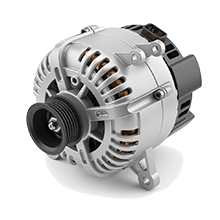
What does an alternator do?
It is the device responsible for generating electricity to charge the battery, and it’s coupled with the engine drive, which means whenever the car is running, the battery is being charged!
Symptoms of a malfunctioning alternator
If your battery is flat and refuses to accept charge through normal driving, or if your headlamps aren’t as bright as normal, then your alternator could be the problem.
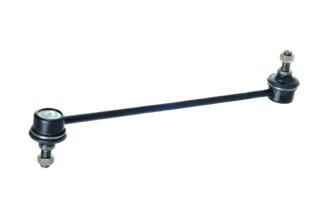
What does an anti-roll bar drop link do?
A drop link is used to connect the end of the anti-roll bar to the damper or a control arm. Its purpose is to keep the vehicle stable during sharp turns by pivoting between the two sides of your car’s suspension.
What are the symptoms of a broken anti-roll bar drop link?
Below are the top three symptoms that could indicate you need to replace your anti-roll bar drop link:
- Poor handling
- Clunking or rattling noises, especially when turning corners
- A rough or bumpy ride
What happens when we do an anti-roll bar drop link replacement on your car?
Our certified mechanics will:
- Inspect your suspension system and potentially test drive your car
- They will then advise on which parts of the suspension need to be replaced
- If necessary they will replace your anti-roll bar drop link(s)
- They will then test drive the car again to be certain that the suspension is fixed

What does Automatic Transmission Fluid (ATF) do?
Automatic Transmission Fluid (ATF) provides the lubrication to the moving parts, wear and corrosion protection and is there to transfer the mechanical power of the automatic transmission.
What are the symptoms of requiring an Automatic Transmission Fluid Flush & replacement?
Usually, there a few signs you can look for:
- Transmission grinding or strange noises
- Problems changing or selecting Gears
- Slipping gears
- Failure to change up or down smoothly
- Jolts or a delay as you change from Park to Drive
- Transmission overheat warnings
- Transmission Control Unit warning lights

What is a car battery replacement?
The car battery is responsible for powering all of the electric components in your car. A car battery is to have an expected lifespan of between 4 to 6 years.
What causes a car battery to stop working correctly?
On occasions when there has been excessive electrical use without your battery being recharged, your battery will be drained. If your car doesn’t start when you turn the ignition switch, especially when the engine doesn’t make any attempt to turn over, your battery could be flat.

What does a brake caliper do?
A caliper forms part of the disc brake system, which most cars have in their front brakes. The brake caliper houses the brake pads and pistons. Its job is to slow the car's wheels by creating friction with the brake rotors.
What are the signs of a bad brake caliper?
Below are the top three symptoms that could indicate you need to replace your brake caliper:
- If your brake pedal feels softer (less resistance when applying the brakes).
- If your car pulls to one side when braking.
- If the level in your brake fluid reservoir drops or if you notice a leak. Brake hydraulic fluid is a very pale golden colour, transparent and almost watery.
What happens when we do a brake caliper replacement on your car?
Our certified mechanics will:
- Inspect the brakes and determine if there’s a problem with one or several of the brake calipers. They will also advise if other parts of the braking system need replacing too.
- They will then replace the brake caliper and other parts of the brake, if necessary.
- Bleed the brake system and top up the brake fluid.
- Test drive the car and inspect the brake system again.
- Make any final, necessary adjustments.

What are brake discs?
The brake disc is a metal plate mounted on the wheel hub that is clamped between 2 brake pads when braking is applied; this causes friction and slows the vehicle down.
Symptoms of malfunctioning brakes discs
Loud screeching or grinding noises from your brakes is an indication that there is a problem with either your brake discs or pads. You can also look through the wheel for a visual check.

What does brake fluid do?
Brake fluid is a special hydraulic fluid that is used to transfer the force created by pressing down on your brake pedal into the brake pads (or shoes) against the brake discs to slow the vehicle.
What are the symptoms of requiring a brake fluid flush & replacement?
Usually, there a few signs you can look for:
- ABS Light Comes On.
- Pedal Problems, braking isn’t as responsive.
- Brake Pads Not Functioning as well as they used to.
- A chemical odor after repeated hard braking.

What does a brake hose do?
A brake hose is designed to transport hydraulic pressure from the brake pipes of your vehicle to its wheel cylinders and brake calipers, this pressure helps the brakes to engage properly when slowing or stopping. Brake hoses are absolutely vital to the safe operation of a vehicle.
What are the symptoms of a malfunctioning brake hose?
Below are the top three symptoms that could indicate you need to replace your brake hose:
- Spongy brake pedal
- Leaking brake fluid - usually a light brown colour
- Faulty or failing brakes
What happens when we do a brake hose replacement on your car?
Our certified mechanics will:
- Inspect the brake system to establish which brake hose needs to be replaced.
- Replace the damaged or faulty brake hose.
- They will then top-up the brake fluid.
- Bleed the brake system.
- Finally they will inspect the brake system and test drive the car to ensure it’s safe.

What does a brake light bulb do?
A brake light bulb is responsible for lighting up your brake lights when you apply the brake pedal. They are a vital safety feature of your car as they ensure you’re visible at night and make other drivers aware when you are braking.
What are the symptoms of a bad brake light bulb?
Below are the top three symptoms that could indicate you need to replace your brake light bulb:
- If your brake lights no longer light up at all when you apply the brakes
- If your brakes lights are dimmer than usual
- Slow responding bulbs
What happens when we do a brake light bulb replacement on your car?
Our certified mechanics will:
- Check your brake lights to see which bulbs need replacing
- They will remove the cover to access the bulb(s)
- They will then replace all the faulty bulbs, ensuring they have the correct bulbs for your make and model
- They will reattach the cover and test the new bulbs by applying the brakes

What are brake pads?
Brake pads are a key component of any vehicle’s braking system. When you use your brakes, the pads hydraulically squeeze the brake discs, slowing your car down through friction and pressure.
Symptoms of malfunctioning brakes pads
A loud screeching or grinding noise when you apply the brakes or feeling your car vibrating under braking is a clear indicator that new pads are required.

What are brake pads?
Brake pads are a key component of any vehicle’s braking system. When you use your brakes, the pads hydraulically squeeze the brake discs, slowing your car down through friction and pressure.
Symptoms of malfunctioning brakes pads
A loud screeching or grinding noise when you apply the brakes or feeling your car vibrating under braking is a clear indicator that new pads are required.

What does a brake pedal switch do?
The brake pedal switch serves two major functions; it turns on the brake lights when a driver presses the brake pedal. It also sends a signal to your car’s computer that the brakes have been applied.
What are the symptoms of a bad brake pedal switch?
Below are the top three symptoms that could indicate you need to replace your brake pedal switch:
- Brake lights stop working or work intermittently
- Brake lights stay permanently on, even when the pedal is not pressed
- Check Engine or ABS system warning light comes on
What happens when we do a brake pedal switch replacement on your car?
Our certified mechanics will:
- First inspect the brake light system and corresponding switch.
- If necessary, the mechanic will replace the faulty brake pedal switch.
- Advise if any related parts need to be replaced or repaired.
- Test the lights again to ensure they function properly and the switch has been installed correctly.
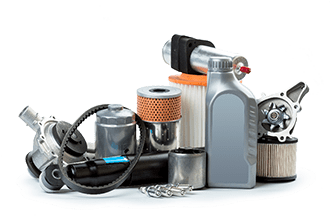
What is a car service?
Usually, we recommend giving your car a full service every year or every 12,000 miles, whichever happens first.

What does a catalytic converter do?
A catalytic converter is an essential part of your exhaust system. Its job is to change harmful substances in a car’s exhaust gasses, such as carbon monoxide nitric oxide, and hydrocarbons, into less harmful gases.
What are the symptoms of a failing catalytic converter?
Below are the top three symptoms that could indicate you need to replace your catalytic converter:
- The smoke from your exhaust is heavier or darker than normal.
- You smell something similar to rotten eggs or sulphur coming from your car’s exhaust.
- You notice a reduction in engine performance.
What happens during a catalytic converter replacement?
Our certified mechanics will:
- Raise your car completely off the ground, making sure that the exhaust has had time to cool down before they begin the replacement.
- Locate the catalytic converter. It usually looks like a box in the middle of the exhaust system underneath the car.
- Remove the catalytic converter, inspect it and fit a replacement if necessary
- Test the new catalytic converter, taking care to double check that the replacement catalytic converter is up to the correct specifications for the vehicle’s emissions standards.

What does a clutch do? And what is a clutch kit?
The clutch is located between the engine and transmission to temporarily disconnect the engine drive from the gearbox. A clutch kit usually contains all the elements to replace and rejuvenate your clutch.
Symptoms of a malfunctioning clutch
If you feel a loss or inappropriate delivery of power when using the accelerator, or if you can’t change gears or it feels like there is unusual grinding and friction when trying, it could be due to a damaged or worn clutch.

What does a coil spring do?
The main purpose of a coil spring is to ensure the wheels remain in good contact with the road surface whilst also providing absorption from bumps and uneven road surfaces. Most cars have four coil springs; each supporting one corner of the vehicle.
What are the symptoms of a broken coil spring?
Below are the top three symptoms that could indicate you need to replace your coil springs:
- Your car is noticeably lower on one side or dipped in one corner.
- You notice strange rattles and knocks when driving on uneven roads.
- Your car’s steering is uneven, or veering off to one side.
What happens when we do a coil spring replacement on your car?
Our certified mechanics will:
- Safely raise the car and inspect the suspension system and coil springs.
- If necessary, they will replace the front or rear pair of coil springs.
- Check other related components and advise whether they need to be replaced.
- Lower the car and check the suspension again.
- Finally they’ll test drive the car.

What does a compressor do?
The compressor is powered by your car’s engine and pumps and pressurizes the refrigerant through the air conditioning system, feeding cold air into your car.
Symptoms of a malfunctioning compressor
If the air conditioning in your car doesn’t function as it normally would, for example, if your air vents aren’t producing cool air, then it could be down to a faulty compressor.
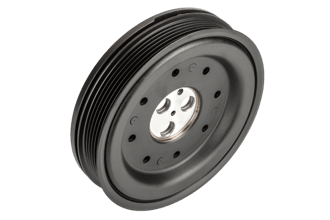
What does a crankshaft pulley do?
The crankshaft pulley is mounted on the end of the crankshaft. Its purpose is to transmit mechanical power and torque through the pulley system to turn the drive belts that operate the engine accessories (alternator, air conditioning compressor, etc.).
What are the symptoms of a bad crankshaft pulley?
Below are the top three symptoms that could indicate you need to replace your crankshaft pulley:
- Engine vibrations
- Alternator failure - flickering headlights, car struggles to start
- Rough engine idle
What happens when we do a crankshaft pulley replacement on your car?
Our certified mechanics will:
- Check the condition of the crankshaft pulley.
- If necessary, they will replace the crankshaft pulley.
- Advise if any other related parts need to be replaced.
- Test drive the car to check everything has been fitted correctly.

What is a diagnostic inspection?
There are hundreds of potential error codes, which only specialist diagnostic equipment can read. So when a warning light flashes on the dashboard, a diagnostics check is needed to assess how bad the problem is, and what may have caused it.
What happens when my dashboard illuminates a warning light?
The warning light is just the beginning—it doesn’t give the whole picture. There are hundreds of parts in your engine, so the exact nature of the fault may not be immediately apparent.

What does a driveshaft do?
The driveshaft isn’t a single part in your car, but rather a series of rod-like components. These parts work together to transfer the rotational power produced in your engine to your wheels so your car can move. Essentially, your driveshaft allows you to drive!
What are the symptoms of a bad driveshaft?
Below are the top three symptoms that could indicate you need to replace your driveshaft:
- Scraping, squeaking and rattling sounds from underneath your car.
- Intense vibrations coming from underneath the car.
- A significant shudder when accelerating from low speed or a stopped position.
What happens during a driveshaft replacement?
Our certified mechanics will:
- Safely jack the car so they can inspect the driveshaft.
- Replace the faulty or damaged driveshaft if necessary.
- Check any related components and advise if any need to be replaced.
- Double check the drive assembly and test drive the car.
- Make any final adjustments, if needed.

What does Engine Coolant Do?
Engine Coolant prevents your engine from overheating in hot weather and freezing in extreme cold weather.
What are the symptoms of requiring an Engine Coolant Flush?
Usually, there a few signs you can look for:
- If you find that your temperature gauge is always high
- Your engine is frequently overheating.
- Engine Warning Light is on.

What does an exhaust silencer do?
A car’s exhaust system is made up of several parts that channel gases from the engine’s cylinders back into the atmosphere. The exhaust silencer is the final section, and its job is to reduce the amount of noise created by the engine gases.
Symptoms of a malfunctioning exhaust silencer
If your exhaust makes more noise or is louder than normal, your exhaust silencer is probably damaged or improperly attached. A common sound of ‘blowing out’ is where holes have developed in the silencer.

What does an exhaust manifold do?
Exhaust manifolds are designed to collect exhaust gases from the engine cylinders and transport them into the exhaust pipes for expulsion. The exhaust manifold is attached to the engine cylinder heads and has ports that collect exhaust gases from each individual engine cylinder.
What are the symptoms of a bad exhaust manifold?
Below are the top three symptoms that could indicate you need to replace your exhaust manifold:
- A noisy engine exhaust
- Burning smell coming from the engine
- Decreased power, acceleration, and fuel efficiency
What happens when we do an exhaust manifold replacement on your car?
Our certified mechanics will:
- Inspect the exhaust manifold.
- If the exhaust manifold is visibly damaged or cracked, it will be replaced.
- If necessary, they may also replace the exhaust gasket and clean the exhaust ports. The manifold's mounting bolts may also need to be replaced.
- Advise if other related components need to be replaced.
- They will then check for any leaks around the manifold and test drive the car.

What does an exhaust pipe do?
Exhaust pipes typically consist of several parts such as a downpipe, a central exhaust pipe and a rear exhaust pipe. Their job is to transport the exhaust gases from the manifold to the catalytic converter to eventually be cleaned and expelled from the vehicle.
What are the symptoms of a bad exhaust pipe?
Below are the top three symptoms that could indicate you need to replace your exhaust pipe:
- Loud noises from the exhaust
- Decreased fuel efficiency
- Loss of power
What happens when we do an exhaust pipe replacement on your car?
Our certified mechanics will:
- Inspect the exhaust pipes.
- If the exhaust system or pipes are damaged (cracked, rusted through etc.), the mechanic will replace the necessary parts.
- They will also replace the exhaust gasket(s), if necessary.
- Advise if other parts need to be replaced.
- Check for any exhaust leaks and test drive the car.

What does a fan belt do?
A fan belt is a flexible synthetic rubber band which connects various engine components together. It’s used to transfer rotational power from one part of the engine to another. It is called the fan belt because one of the shafts which it connects to is the spinning engine cooling fan.
What are the symptoms of a bad fan belt?
Below are the top three symptoms that could indicate you need to replace your fan belt:
- A squeaking or whining noise whenever the engine is switched on
- If your fan belt is visibly worn, cracked or torn
- If your engine overheats regularly
What happens during a fan belt replacement?
Our certified mechanics will:
- Inspect the fan belt for signs of wear and cracks.
- They will also inspect the belt's pulleys and tensioner.
- Replace the belt, if necessary.
- Advise if any other related repairs are necessary.

What does a front fog lamp do?
A front fog light is responsible for illuminating the road in front of your vehicle when driving in poor visibility. They are not mandatory in the UK, however they are useful in thick fog to illuminate the road ahead. They also alert other road users to your presence on the road which may not be immediately obvious with poor visibility.
What are the signs of a bad fog lamp?
Below are the top three symptoms that could indicate you need to replace your fog lamp bulb:
- If one or both of your fog lights has stopped working
- If your fog lights are dimmer than usual
- If you have noticed your fog lights flickering or dipping in and out
What happens when we do a fog lamp replacement on your car?
Our certified mechanics will:
- Inspect the fog lights and test to see which ones need replacing
- They will then disconnect any power wires attached to the fog lights
- Unscrew or unclip the old fog light bulb that needs replacing
- Fit the new fog light bulbs, ensuring they’re the correct size and type for your car make and model
- They’ll reconnect the power wires and test that the new bulb is working

What does a rear fog lamp bulb do?
A rear fog light is required by UK law on all vehicles. These lights warn traffic of your presence when they are closing in on you from behind in poor conditions, making them an important safety feature on your car.
What are the signs of a bad fog lamp bulb?
Below are the top three symptoms that could indicate you need to replace your fog lamp bulb:
- If one or both of your fog lights has stopped working
- If your fog lights are dimmer than usual
- If you have noticed your fog lights flickering or dipping in and out
What happens when we do a fog lamp bulb replacement on your car?
Our certified mechanics will:
- Inspect the fog lights and test to see which ones need replacing
- They will then disconnect any power wires attached to the fog lights
- Unscrew or unclip the old fog light bulb that needs replacing
- Fit the new fog light bulbs, ensuring they’re the correct size and type for your car make and model
- They’ll reconnect the power wires and test that the new bulb is working

What is included in an air con check?
During the check our mechanic will check your air con pressure, the quantity of gas, make sure there are no leaks and check your refrigerant levels to see if your system needs to be regassed for optimal performance. If you do require an aircon regas or repair, the mechanic will be happy to provide you with a free, no-obligation quote upfront.
How do I know if my car aircon needs regassing or servicing?
Typically, you'll notice that the air blowing from your vents isn't as cold as it usually is. Or if there is a more serious problem with your air conditioning system, it might not be blowing any air at all.

What is included in a car battery check?
Our experienced mechanics will visually check your battery, its terminals and connectors for signs of damage and corrosion. They will assess the efficiency of your battery and its ability to retain charge. They can then advise whether or not they think a replacement is needed.
How do I know if my battery needs replacing?
Some common signs that your battery may need replacing are:
- Trouble starting your car
- Your car completely fails to start
- Problems with your car's electrics
- Rust or corrosion around your battery terminals

What is included in a car brake check?
Each key brake component will be inspected by our highly experienced mechanics. They will visually check the thickness of your brake pads, and the condition of your calipers and brake discs. Depending on the condition of these parts they can then advise whether or not they think a replacement is needed.
How do I know if my brakes need replacing?
Some common signs that your brakes may need replacing are:
- You hear unusual noises, such as squeaking or grinding, when braking
- Your vehicle pulls to one side when braking
- You feel vibrations or shudders when braking
- Your brakes feel hard or spongy when applying pressure
- There is additional slack in the handbrake or difficulty removing handbrake
- The brake warning light is illuminated

What is included in a free exhaust check?
Our trusted mechanics will carry out an efficient exhaust inspection, involving thorough checks of the exhaust pipes, silencer, catalytic converter and more.
How do I know if my car exhaust needs replacing?
Some common signs that your exhaust may need replacing are:
- Loud, roaring noises
- Bad fumes
- Reduced fuel efficiency
- Rattling or hissing noises
- Holes or cracks in your exhaust
- Rust or corrosion

What is included in a fluid level check?
During a free fluid level check our mechanics will check all fluid reservoirs, including engine oil, brake fluid and windscreen washer fluid. They will advise which, if any, fluids need to be topped up or changed.
How do I know if my car fluids are low?
Some common signs that your car fluids may need replacing are:
- Burning oil smell in and around your car
- Strange noises
- Weaker engine performance
- Overheating engine
- ABS comes on
- Engine warning light illuminates

What is included in a steering system check?
Our free car steering check covers all major parts. Our top-rated mechanics will check your power steering fluid levels, the condition and quality of the power steering fluid, steering geometry, steering wheel and more.
How do I know if my steering system needs repairing?
Some common signs that your steering may need repairing are:
- Very difficult to turn the steering wheel
- Uneven or premature tyre wear
- Power steering fluid pump is making a whining noise
- Power steering fluid looks black or brown
- Car pulls to one side when driving or your steering seems to be “wandering”

What is included in a suspension check?
Our free suspension check involves an inspection of all the major components of the system. Our mechanics will then be able to give their opinion on any repairs or parts that may need to be replaced.
How do I know if my suspension needs repairing?
Some common signs that your suspension may need repairing are:
- Your car has become difficult to handle
- A rough or bumpy ride
- Your car is drifting or pulling to one side
- Car sits low/nose dives
- Damaged or oily shock absorbers

What is included in a timing belt check?
A timing belt check will involve a thorough inspection of the timing belt and its related components. These checks are particularly important to carry out on belts that are over 4 or 5 years old - because the timing belt is made of rubber, it will wear down over time and eventually break.
How do I know if my timing belt needs replacing?
Some common signs that your timing belt may need replacing are:
- Engine is making a ticking noise
- Engine struggles or fails to turn over
- Rough engine idle
- Engine misfires frequently
- Drop in oil pressure or an oil leak

What is included in a car tyre check?
Our experienced mechanics will visually inspect the condition and tread of all of your tyres. If necessary they may also check your tyre pressures to ensure they align with the manufacturer guidelines.
How do I know if my tyres need replacing?
Some common signs that your tyre may need replacing are:
- There's not enough tread depth
- You're experiencing a shaky drive
- You hear squeaks, whines or other strange noises when driving
- You can see cracks in your tyres
- You've noticed bulges or blisters
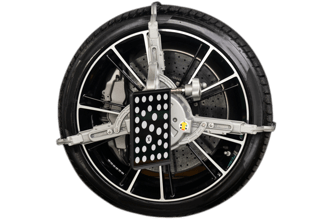
What is a front wheel alignment?
Wheel alignment (or tracking), is the process of ensuring your vehicle’s wheels are set to the optimum position, as per the manufacturer’s specifications.
What are the symptoms of common wheel alignment problems?
Common symptoms include: excessive wear to steering or suspension components, hitting a kerb or driving into a pothole in the road.
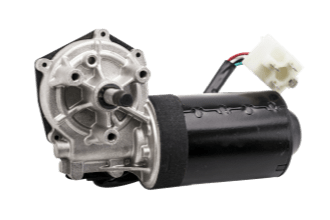
What does a front wiper motor do?
The role of a front wiper motor is to power a car’s front windscreen wiper arms. This small electric motor provides the power needed for the windscreen wipers to swipe across the windscreen glass, clearing rain water, ice, dirt and debris as they go.
What are the signs of a failing front wiper motor?
Below are the top three symptoms that could indicate you need to replace your front wiper motor:
- If one or both of the windscreen wipers completely stops working
- If the wipers move slower than usual
- If the wipers jerk across the windscreen or aren’t swiping as smoothly as usual
What happens during a front wiper motor replacement?
Our certified mechanics will:
- Inspect the front windscreen wiper system.
- Investigate to determine the exact fault in the electrical system.
- If necessary, they will replace the front windscreen wiper motor.
- They will advise if any other parts of the windscreen wipers need to be replaced.
- Finally they will test the windscreen's wipers to ensure everything is working correctly.

What does a fuel filter do?
A fuel filter's purpose is to filter out potentially harmful dirt or debris that could enter the fuel system. Not only does it help to protect your fuel pump and injectors, it also plays a significant role in ensuring that you are achieving the highest fuel-efficiency possible.
What are the symptoms of a bad fuel filter?
Below are the top three symptoms that could indicate you need to replace your fuel filter:
- Trouble starting your car
- Rough idling
- Poor mileage
What happens during a fuel filter replacement?
Our certified mechanics will:
- Inspect the fuel filter and the fuel supply system.
- Replace the fuel filter if necessary.
- Advise if any other parts need to be replaced, such as the fuel pump.
- Inspect the fuel system again for any leaks and test drive the car.

What does a fuel hose do?
Fuel hoses, also commonly referred to as fuel lines, are the rubber tubes in the fuel system that deliver fuel from the tank to the engine. They are specifically designed to deal with the pressure of modern fuel delivery systems.
What are the symptoms of a bad fuel hose?
Below are the top three symptoms that could indicate you need to replace your fuel hose:
- Fuel smell in your car
- Visible cracks on the fuel hose
- Visible fuel leaks - either small drips or puddles under your car. Learn more about fluid leaks here
What happens when we do a fuel hose replacement on your car?
Our certified mechanics will:
- Inspect the entire fuel system for any issues
- Remove the fuel cap
- If necessary, they will remove the defective fuel hose
- The new fuel hose is installed
- Refit the gas cap and start the engine to check for fuel leaks
- Test drive the car and check the entire fuel system for leaks

What does a fuel pump relay do?
The fuel pump relay is the electronic component that controls power to the fuel pump. It is found on virtually all vehicles with an internal combustion engine and is often located in the fuse box which can be found in the engine bay.
What are the signs of a bad fuel pump relay?
Below are the top three symptoms that could indicate you need to replace your fuel pump relay:
- Poor fuel economy
- Trouble starting your car
- Poor engine performance - stalling, poor acceleration, rough idling
What happens when we do a fuel pump relay replacement on your car?
Our certified mechanics will:
- Inspect the entire fuel system and test it for any issues
- They will then locate the fuse box, usually found in the engine bay
- If necessary, they will remove the old relay and replace it with a new one
- They will they retest the fuel system and check the fuel pump is working
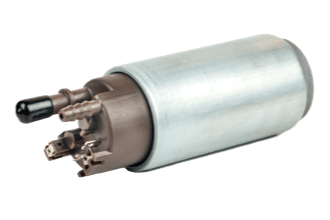
What does a fuel pump do?
Most modern vehicles that use an internal combustion engine are equipped with a fuel pump. It’s a small pump which sends the fuel from the tank to the engine. The pump may be mechanically worked by the engine, but on most modern cars it’s electrically-powered. In this case it’s usually found next to or even inside the fuel tank.
What are the symptoms of a malfunctioning fuel pump?
Below are the top three symptoms that could indicate you need to replace your fuel pump:
- Trouble starting your car could indicate issues with the fuel pump.
- A rough or unsteady engine.
- A hissing noise coming from near the fuel tank.
What happens when we do a fuel pump replacement on your car?
Our certified mechanics will:
- Use diagnostic equipment to read the ECU for possible fuel system related fault codes.
- Inspect the fuel supply system and the fuel pump.
- Replace the fuel pump if necessary.
- Inspect other related components and advise if any need to be replaced (like the fuel filter).
- Test drive the car and check for any leaks.

What do headlight bulbs do?
Headlight bulbs are used to illuminate your car’s headlights. They give you maximum visibility while driving and also ensure that your vehicle is visible to oncoming traffic, making them a crucial safety feature.
What are the signs of a broken headlight bulb?
Below are the top three symptoms that could indicate you need to replace your headlight bulb:
- If one or both of your headlights has stopped working
- If your headlights are dimmer than usual
- If you have noticed your headlights flickering or dipping in and out
What happens when we do a headlight bulb replacement on your car?
Our certified mechanics will:
- Inspect the headlight holders and test to see which ones need replacing
- They will then disconnect the headlight bulb power wires
- Unscrew the old headlight bulb(s) that need replacing
- Fit the new headlight bulbs, ensuring they’re the correct size and type for your car make and model
- They’ll reconnect the power wires and test that the new bulb is working
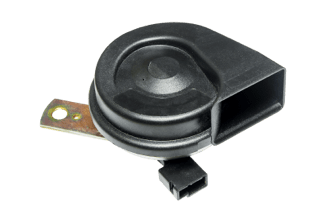
What does a horn assembly do?
A functioning horn is an essential safety component of any vehicle on the road. The horn assembly refers to the system that allows you to sound your car’s horn. This usually includes the horn button (located in the centre of the steering wheel), the horn relay, and the horn(s) which are usually located under the bonnet.
What are the symptoms of a bad horn assembly?
Below are the top three symptoms that could indicate you need to replace your horn assembly:
- Your horn makes no sound when the button is pressed
- Your horn is too quiet to be heard by other road users
- Clicking sound from the horn relay
What happens when we do a horn assembly replacement on your car?
Our certified mechanics will:
- Inspect the entire horn assembly and identify the part(s) that need replacing
- Disconnect the battery
- Replace the necessary parts, either the button, relay or the horns
- Reconnect the battery and test the horn

What does an indicator do?
Indicator bulbs are typically located in both headlight units, rear light units and at the side of wing mirrors on many modern vehicles. Your indicators are an important safety feature used to indicate your intentions when driving.
What are the signs of a failing indicator bulb?
Below are the top three symptoms that could indicate you need to replace your indicator bulb:
- If your indicators no longer light up when switched on
- If your indicators are dimmer than usual
- Your indicators work sometimes but not always
What happens when we do an indicator bulb replacement on your car?
Our certified mechanics will:
- Inspect all the indicators and test to see which bulbs need replacing
- They will then disconnect the indicator bulb power wires
- Unscrew the old indicator bulb(s) that need replacing
- Fit the new indicator bulbs, ensuring they’re the correct size and type for your car make and model
- They’ll reconnect the power wires and test that the new bulb is working

What does an instrument panel bulb do?
A car’s instrument panel bulb is responsible for lighting the instrument panel, or dashboard. This panel is located directly in front of the driver, behind the steering wheel and displays important information about the performance of your car.
What are the symptoms of a broken instrument panel bulb?
Below are the top three symptoms that could indicate you need to replace your instrument panel bulb:
- Your car dashboard isn’t lit
- Dashboard warning lights are flickering or not displaying
- Your indicator dashboard lights aren't flashing
What happens when we do an instrument panel bulb replacement on your car?
Our certified mechanics will:
- Remove the instrument panel front
- Check all fuses and bulbs connected to the instrument panel
- Replace any faulty fuses or bulbs
- Refit the instrument panel front and test the lights are working

What does an intake manifold gasket do?
The intake manifold gaskets are responsible for sealing the intake manifold against the cylinder head or heads depending on the engine. This gasket ensures no air leaks out as it travels from the air inlets into the intake manifold and eventually reaches the engine where it helps to burn the fuel inside the engine cylinder.
What are the symptoms of a bad intake manifold gasket?
Below are the top three symptoms that could indicate you need to replace your intake manifold gasket:
- When the engine is running at a higher temperature or overheating more than usual.
- When there is fluid under the car, coming from the engine.
- When the engine does not run as smoothly as usual.
What happens when we do an intake manifold gasket replacement on your car?
Our certified mechanics will:
- Inspect the intake manifold and gasket for leaks.
- Read the car's ECU to find any fault codes.
- Clean the air intake ports of the engine of dirt buildup.
- If necessary, they will replace the intake manifold gasket.
- Advise if other related parts need to be replaced.
- Finally they will test drive the car.
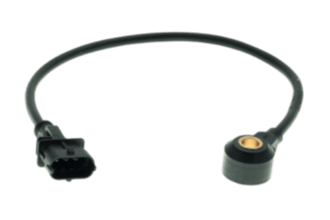
What does a knock sensor do?
The knock sensor is bolted directly onto the outside of the engine block and is used to detect vibrations and detonation “knock” noises from the engine to prevent engine damage.
What are the symptoms of a bad knock sensor?
Below are the top three symptoms that could indicate you need to replace your knock sensor:
- Engine pre-detonation known as “pinking” or knocking
- Reduced engine power
- Increased fuel consumption
What happens when we do a knock sensor replacement on your car?
Our certified mechanics will:
- Perform a diagnostic check to discover any fault codes coming from the knock sensor and other related parts of the engine.
- Once they confirm that the knock sensor is faulty, they will fit a replacement knock sensor.
- Once replaced, the mechanic will start the engine and recheck for fault codes.

What does a lambda sensor do?
In simple terms, a lambda sensor measures the amount of oxygen in your exhaust fumes, to ensure your engine is burning fuel correctly. They are fitted in both petrol and diesel vehicles.
What are the symptoms of a malfunctioning lambda sensor?
Below are the top three symptoms that could indicate you need to replace your {part/repair}:
- Your engine performance will suffer—often misfiring, cutting out or not starting at all
- When your engine is idling, or just ticking over, it will feel rough and lumpy compared to normal
- Fuel consumption is higher than normal
What happens when we do a lambda sensor replacement on your car?
Our certified mechanics will:
- Read the ECU for possible fault codes related to the lambda sensor.
- They will inspect the sensor and ancillaries (like the electrical connectors).
- If necessary, the mechanic will replace the lambda sensor.
- The mechanic will advise if other components need to be replaced as well.
- They will check the sensors again.
- The mechanic will test drive the car, and make any final adjustments.

What does a lower ball joint do?
The ball joints connect the control arm to the steering knuckles and allow for smooth and solid movement in the suspension. The front suspension of most cars has at least lower ball joints and some may have upper ones as well.
What are the signs of a failing lower ball joint?
Below are the top three symptoms that could indicate you need to replace your lower ball joint:
- Car vibrates whilst driving. Can often be felt through the steering wheel.
- Thudding or clunking noises coming from one of the wheels on the car.
- Car feels unstable or pulls to one side.
What happens when we do a lower ball joint repair on your car?
Our certified mechanics will:
- Safely jack your car and remove the wheels.
- Inspect the ball joints.
- If necessary they will replace the faulty ball joint(s).
- They will advise if any other related components need to be replaced.
- Next they will realign your car’s wheels.
- Finally they’ll re-check the suspension and test drive the car.

What's an MOT?
The MOT test is how the government checks your vehicle meets national safety and environmental standards. At Fixter, we make the process hassle-free with our straightforward, no-nonsense UK-wide service.

What is an MOT & Service Bundle?
A service is recommended every 12-months and all vehicles after 3-years-old or more require an annual MOT test by law. Save yourself the extra effort, combine your MOT with a Full Service, and save yourself time and money.
- MOT
- All Legal Checks
- Full Service
- 71+ Maintenance checks

What does oil and oil filter do?
Your engine oil is designed to keep all the internal workings of your engine running smoothly and safe from harm. It protects moving parts by removing friction, and in doing so, prolongs their life. For a relatively small expense, your oil and filter change cost could add years to the life of your engine.
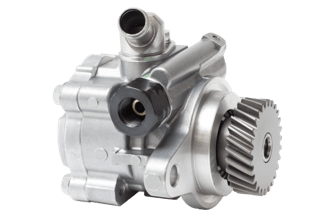
What does an oil pump do?
The oil pump’s job is to circulate oil under pressure from the oil pan into the car’s oil circuit. This oil is needed to lubricate parts like the rotating bearings, sliding pistons and camshaft where constant, fluid movement is essential.
What are the symptoms of a bad oil pump?
Below are the top three symptoms that could indicate you need to replace your oil pump:
- Low oil pressure (this could be indicated by your engine warning light)
- Increased engine operating temperature
- Tapping or pinging noises coming from the engine
What happens when we do an oil pump replacement on your car?
Our certified mechanics will:
- Safely raise your vehicle
- Drain the oil from your engine and pump
- Remove the oil sump pan
- Replace the oil pump and re-assemble the other components
- Add fresh engine oil and fit a new oil filter
- They will run the engine check the oil pressure and inspect the engine for leaks

What does power steering fluid do?
Power steering fluid is the hydraulic fluid that transmits the power in your steering system. It helps create the pressure that pushes on either side of your car’s rack-mounted piston, allowing you to turn the wheels with ease.
What are the symptoms of needing a power steering fluid flush and replacement ?
Below are the top 3 symptoms that could indicate you need to flush your power steering fluid:
- It’s difficult to turn the steering wheel while driving.
- Pump is making a whining noise
- Fluid looks black or brown

What does a car radiator do?
The radiator is a component in the engine that keeps the car's engine coolant cool. Without the radiator, a car would quickly run into trouble and serious problems could arise. The radiator is part of the cooling system ensuring the car does not overheat.
What are the symptoms of a malfunctioning car radiator?
Below is the top 3 symptoms that could indicate you need to replace your car radiator: If the 'Check Engine' warning light is on. There are leaks on the radiator (or even around it). Your engine is overheating, which means it’s running at a higher temperature than usual.

What are shock absorbers?
They are responsible for your vehicle’s smooth drive over bumpy or uneven roads and are an essential part of your suspension system.
Symptoms of a malfunctioning shock absorber
If your car is providing uncomfortable ride quality and is bouncing excessively, it could be that your shock absorbers aren’t operating correctly. Also, any puddles of oil-like fluid on the road around your wheels could be escaping from leaking shock absorbers.

What are shock absorbers?
They are responsible for your vehicle’s smooth drive over bumpy or uneven roads and are an essential part of your suspension system.
Symptoms of a malfunctioning shock absorber
If your car is providing uncomfortable ride quality and is bouncing excessively, it could be that your shock absorbers aren’t operating correctly. Also, any puddles of oil-like fluid on the road around your wheels could be escaping from leaking shock absorbers.

What do spark plugs do?
They convert electric current from the ignition coil into a spark that ignites the fuel and air mix inside the car engine. This combustion is what powers the engine and moves the car.
Symptoms of malfunctioning spark plugs
If your car struggles or fails to start, or if your engine cuts out after starting or during its usual operation, or if it fails to run smoothly or it vibrates excessively under normal use it could be down to faulty spark plugs.

What does a starter motor do?
The starter motor is the component responsible for turning over or ‘cranking’ the engine to start the car. Without a functioning starter motor, it’s not possible to start a car by using the ignition alone. The starter motor is a key component of a smooth running vehicle.
What are the symptoms of a malfunctioning starter motor?
Below is the top 3 symptoms that could indicate you need to replace your starter motor: If the 'Check Engine' warning light is on. When trying to start the car you hear a ‘clicking noise’. When trying to start the car you hear a grinding or whirring noise this may signify issues with your starter motor.

What does a thermostat do?
Your car's thermostat plays a vital role in your car’s cooling system. It’s a valve that regulates the amount of coolant that is recirculated back into the engine and how much is cooled via the radiator prior to being recirculated. This process is what keeps your vehicle’s engine functioning at the optimum temperature.
What are the signs of a faulty thermostat?
Below are the top three symptoms that could indicate you need to replace your thermostat:
- If your ‘Check Engine’ warning light is on.
- If the ‘Engine Temperature’ warning light illuminates.
- Your temperature gauge reading is very high and your engine keeps overheating.
What happens when we do a thermostat replacement on your car?
Our certified mechanics will:
- Read your car’s ECU to see if there are any related fault codes.
- Inspect the thermostat and the cooling system.
- Replace the thermostat, if needed.
- Close the cooling system and top-up your engine coolant.
- Run the engine and test drive the car.
- Make any final, necessary adjustments.

What does a throttle body do?
The throttle body is a critical piece of the air intake system that controls the amount of air flowing into the engine. It consists of a pivoting flat valve and is located between the air intake and engine manifold where fresh air is pulled into the engine for the combustion process.
What are the symptoms of a bad throttle body?
Below are the top three symptoms that could indicate you need to replace your throttle body:
- A very poor or rough idle
- Poor or unreliable acceleration
- Excess fuel consumption
What happens when we do a throttle body repair on your car?
Our certified mechanics will:
- Analyse the ECU to see if there are any related fault codes.
- Inspect the throttle body and air intake system.
- Replace the throttle body if there are issues with it.
- Clean the air intake system of dirt and residue.
- Advise if any other parts need to be replaced.
- Finally they will run the engine and test drive the car.

What does a timing belt do?
It is a vital engine component with a key role to play in keeping your motor running smoothly. It ensures the top and bottom halves of your engine rotate precisely in time with each other.
Symptoms of a malfunctioning timing belt
Like most car parts, your timing belt will wear out eventually due to cracking, snapping or tearing. If a grinding or squeaking noise is being emitted from your engine, it could be a malfunctioning timing belt.

What does a track rod end do?
A track rod end is a small, flexible ball joint which sits on the end of the tie rods, connecting them to the steering rack and front wheel steering knuckle. Together these components perform an essential role in a car’s steering function.
What are the signs of a bad track rod end?
Below are the top three symptoms that could indicate you need to replace your track rod end:
- Vibrations in the steering wheel
- If your steering is not as precise as usual
- Knocking when you drive over bumps or when changing direction
What happens during a track rod end replacement?
Our certified mechanics will:
- Safely raise the vehicle and remove the road wheel
- They will then undo the component from the steering knuckle and tie rod
- A new track rod end will be fitted
- The wheel will be put back on and the mechanic will test drive your car to ensure the parts are working and fitted correctly
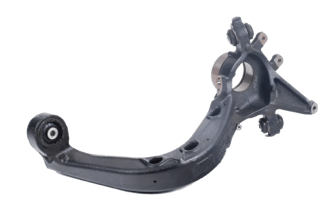
What does a trailing arm do?
A trailing arm is part of the suspension for the axle of a vehicle which moves up and down as the vehicle travels over a bumpy surface. It’s job is to act as a pivot point and stop the rear axle or rear spindle from moving forward or rearward during operation of the vehicle.
What are the symptoms of a bad trailing arm?
Below are the top three symptoms that could indicate you need to replace your trailing arm:
- Clunking noises from the back of your car
- Vehicle won’t stay in a straight line or sways to one side when driving
- Your rear tires are wearing unevenly and excessively
What happens when we do a trailing arm replacement on your car?
Our certified mechanics will:
- Inspect your suspension system, including the trailing arm.
- If the trailing arm is cracked or damaged they will fit a replacement.
- They will advise if any related parts need to be replaced.
- They will check that all parts have been fitted correctly and test drive the car.

What does a water pump do?
Your car’s water pump is located in the engine bay and is usually powered from the engine drive belt. It is responsible for circulating the engine coolant around the cooling system.
Symptoms of a malfunctioning water pump
If there are patches or puddles of fluid on the floor beneath your engine, it could be a leaking water pump. It is imperative that your water pump operates correctly, as failure to pump coolant through your engine can cause engine overheating.

What does a wheel bearing do?
A wheel bearing is a crucial part of the wheel assembly that connects the wheel and the axle. It is a circle of ball bearings secured in a ring called a 'race'. A wheel bearing enables the wheel to rotate smoothly with minimal friction.
What are the signs of a bad wheel bearing?
Below are the top three symptoms that could indicate you need to replace your wheel bearing:
- If you notice a grinding, grating or humming noise coming from your wheel or tyre. This noise usually increases with acceleration or as the vehicle turns.
- A car that feels loose as you drive it - your steering seems less responsive or less precise than usual.
- Steering wheel vibration which changes with speed or as your car turns.
What happens during a wheel bearing replacement?
Our certified mechanics will:
- Jack the car safely and inspect the wheel with the faulty bearing.
- Replace the faulty bearing, if necessary.
- Refit the bearing and wheel.
- Torque the wheel to the correct pressure. This is set by the car manufacturer.
- Test drive the car.
- If necessary, they will make any final adjustments.
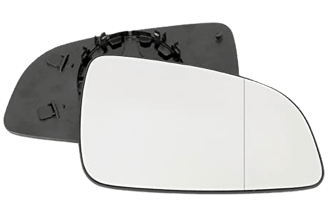
What does a wing mirror do?
Also known as side view or door mirrors, wing mirrors are one of the most important safety features on your car. Although they may not seem important, your wing mirrors keep you aware of vehicles, people and other obstacles around your car. Legally in the UK, you need two working mirrors and one must be the driver's side wing mirror.
What are the symptoms of a broken wing mirror?
Below are some signs that you may need to replace your wing mirror glass:
- If the glass panel in your wing mirror is smashed or cracked to the extent that it prevents you from clearly viewing the rear of your car, it will need to be replaced.
- If your wing mirror glass is stuck in the incorrect position it may have seized so will need repairing.
- If snow, water or dew take a while to clear off the glass, the electric heating element in your wing mirror could be broken.

What does a wing mirror do?
Also known as side view or door mirrors, wing mirrors are one of the most important safety features on your car. Although they may not seem important, your wing mirrors keep you aware of vehicles, people and other obstacles around your car. Legally in the UK, you need two working mirrors and one must be the driver's side wing mirror.
What are the symptoms of a broken wing mirror?
Below are some signs that you may need to replace your wing mirror:
- If your wing mirror is damaged and no longer provides an adequate view of the rear of your car.
- If your electric wing mirror no longer moves or is stuck in one position.
- If your driver’s side wing mirror is missing, legally you must have it replaced.
What happens during a wing mirror replacement on your car?
Our certified mechanics will:
- Inspect the damaged wing mirror by removing the casing or panels.
- Test the electrical systems, if the wing mirror is electric.
- If necessary, they will replace the mirror unit, the mirror glass or both. If there is a fault in the electrics they may fit a completely new wing mirror.
- Test if the mirror moves properly and ensure it provides a view of the car’s rear.

Why should I get a winter health check?
As the evenings grow darker and the weather gets colder, roads can be icy and hazardous in the winter months. A winter health check will ensure that your car is safe and reliable for the season, so you can feel confident on the roads whatever the weather.
Does my car need a winter health check?
Freezing temperatures, damp conditions and icy roads take their toll on your vehicle. Over time your car may be in need of some TLC to make sure it can keep you safe on the roads. Our mechanics will perform vital safety checks and run tests on your vehicle to keep it in top condition for those long winter nights and chilly mornings.
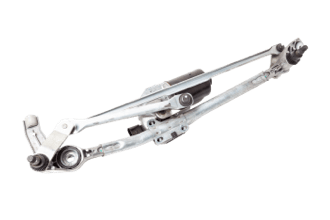
What does a wiper linkage do?
The wiper linkage is the component that attaches the windscreen wiper motor to the wiper arms and blades. It plays a key role in ensuring the driver has good visibility at all times.
What are the symptoms of a broken wiper linkage?
Below are the top three symptoms that could indicate you need to replace your wiper linkage:
- If the wiper arms get stuck at various points on the windscreen
- If you can hear the motor running but the arms are not moving
- If only one wiper arm moves
What happens when we do a wiper linkage replacement on your car?
Our certified mechanics will:
- Inspect the windscreen wiper system and carry out checks to determine the exact fault.
- If necessary, they will replace the windscreen wiper linkage.
- They will then advise if any other parts need to be replaced.
- The mechanic will test the windscreen wiper system to ensure it works correctly.
- They will make any final adjustments, if necessary.

What do wiper blades do?
Wiper blades are the thin rubber inserts that form part of the windscreen wipers. Windscreen wipers or windshield wipers are the arm-like devices used to clear rain, snow, ice, washer fluid, water, or debris from a vehicle's front window so the driver always has a clear view of what's ahead of them.
What are the signs of a bad wiper blade?
Below are the top 3 signs that could indicate you need to replace your wiper blades:
- Streaking - if your wiper blades leave streaks on your windscreen they'll likely need replacing.
- Squeaking - your wiper blades may need replacing or readjusting if they make a squeaking noise.
- Smearing on your windscreen could be a sign that your blades are worn and need replacing.
What happens when we do a wiper blades replacement on your car?
Our certified mechanics will:
- Test your windscreen wipers to determine which part or parts need to be changed.
- If your wiper blades need to be replaced the mechanic will unclip them or slide them out of the wiper arm.
- They will then fit the new blades, ensuring they are the correct size and type for your car.
- Test the new blades to ensure they work effectively.

What are brake discs?
The brake disc is a metal plate mounted on the wheel hub that is clamped between 2 brake pads when braking is applied; this causes friction and slows the vehicle down.
Symptoms of malfunctioning brakes discs
Loud screeching or grinding noises from your brakes is an indication that there is a problem with either your brake discs or pads. You can also look through the wheel for a visual check.

What does an air conditioning condenser do?
It converts the refrigerant gas into a cold liquid to provide chilled air throughout your vehicle. It basically helps keep you and your passengers at a comfortable temperature on a hot day.
Symptoms of a malfunctioning condenser
If you notice that the air conditioning in your car isn’t providing the usual levels of cold air as normal (or if it isn’t working at all), then your condenser could have stopped working correctly.
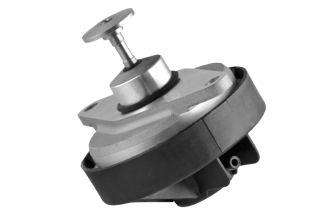
What does an EGR Valve motor do?
The valve controlling your EGR (exhaust gas recirculation) controls the amount of nitrogen oxide emitted into the atmosphere by engines by recycling part of the exhaust gas back into the engine cylinders.
What are the symptoms of a malfunctioning EGR Valve motor?
A rough idle when starting your vehicle or during brief stops (i.e. low engine speeds with a warmed-up engine) can be caused when the EGR is constantly open and a continuous flow of exhaust gases goes into the intake manifold. Poor performance can be caused when the valve is open or closed. The incorrect function of the EGR valve can cause the erratic performance of your vehicle.
How it works
Car maintenance, made easy in 4 steps
1 Book online in 2 clicks
Benefit from our pre-negotiated rates, book a time, and we’ll take care of the rest.

2 We collect your car
Our fully insured drivers collect your car, right from your doorstep.

3 We fix your car
Our top-rated vetted garages get to work - while we keep you informed.

4 We return your car
We bring your car home, safe and sound.


